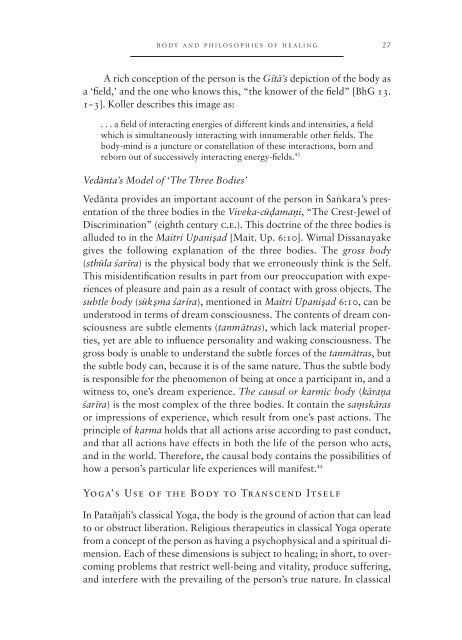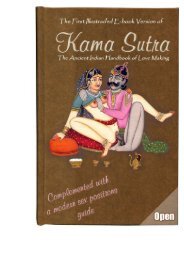body and health in yoga, Ayurveda, and Tantra
body and health in yoga, Ayurveda, and Tantra
body and health in yoga, Ayurveda, and Tantra
You also want an ePaper? Increase the reach of your titles
YUMPU automatically turns print PDFs into web optimized ePapers that Google loves.
ody <strong>and</strong> philosophies of heal<strong>in</strong>g 27<br />
A rich conception of the person is the G¯ıtā’s depiction of the <strong>body</strong> as<br />
a ‘field,’ <strong>and</strong> the one who knows this, “the knower of the field” [BhG 13.<br />
1–3]. Koller describes this image as:<br />
. . . a field of <strong>in</strong>teract<strong>in</strong>g energies of different k<strong>in</strong>ds <strong>and</strong> <strong>in</strong>tensities, a field<br />
which is simultaneously <strong>in</strong>teract<strong>in</strong>g with <strong>in</strong>numerable other fields. The<br />
<strong>body</strong>-m<strong>in</strong>d is a juncture or constellation of these <strong>in</strong>teractions, born <strong>and</strong><br />
reborn out of successively <strong>in</strong>teract<strong>in</strong>g energy-fields. 43<br />
Vedānta’s Model of ‘The Three Bodies’<br />
Ved¯anta provides an important account of the person <strong>in</strong> Ía˙nkara’s presentation<br />
of the three bodies <strong>in</strong> the Viveka-cūÓdamaÓni, “The Crest-Jewel of<br />
Discrim<strong>in</strong>ation” (eighth century c.e.). This doctr<strong>in</strong>e of the three bodies is<br />
alluded to <strong>in</strong> the Maitri UpaniÓsad [Mait. Up. 6:10]. Wimal Dissanayake<br />
gives the follow<strong>in</strong>g explanation of the three bodies. The gross <strong>body</strong><br />
(sthūla ´sar¯ıra) is the physical <strong>body</strong> that we erroneously th<strong>in</strong>k is the Self.<br />
This misidentification results <strong>in</strong> part from our preoccupation with experiences<br />
of pleasure <strong>and</strong> pa<strong>in</strong> as a result of contact with gross objects. The<br />
subtle <strong>body</strong> (sūkÓsma ´sar¯ıra), mentioned <strong>in</strong> Maitri UpaniÓsad 6:10, can be<br />
understood <strong>in</strong> terms of dream consciousness. The contents of dream consciousness<br />
are subtle elements (tanmātras), which lack material properties,<br />
yet are able to <strong>in</strong>fluence personality <strong>and</strong> wak<strong>in</strong>g consciousness. The<br />
gross <strong>body</strong> is unable to underst<strong>and</strong> the subtle forces of the tanmātras, but<br />
the subtle <strong>body</strong> can, because it is of the same nature. Thus the subtle <strong>body</strong><br />
is responsible for the phenomenon of be<strong>in</strong>g at once a participant <strong>in</strong>, <strong>and</strong> a<br />
witness to, one’s dream experience. The causal or karmic <strong>body</strong> (kāraÓna<br />
´sar¯ıra) is the most complex of the three bodies. It conta<strong>in</strong> the saÓmskāras<br />
or impressions of experience, which result from one’s past actions. The<br />
pr<strong>in</strong>ciple of karma holds that all actions arise accord<strong>in</strong>g to past conduct,<br />
<strong>and</strong> that all actions have effects <strong>in</strong> both the life of the person who acts,<br />
<strong>and</strong> <strong>in</strong> the world. Therefore, the causal <strong>body</strong> conta<strong>in</strong>s the possibilities of<br />
how a person’s particular life experiences will manifest. 44<br />
Yoga’s Use of the Body to Transcend Itself<br />
In Patañjali’s classical Yoga, the <strong>body</strong> is the ground of action that can lead<br />
to or obstruct liberation. Religious therapeutics <strong>in</strong> classical Yoga operate<br />
from a concept of the person as hav<strong>in</strong>g a psychophysical <strong>and</strong> a spiritual dimension.<br />
Each of these dimensions is subject to heal<strong>in</strong>g; <strong>in</strong> short, to overcom<strong>in</strong>g<br />
problems that restrict well-be<strong>in</strong>g <strong>and</strong> vitality, produce suffer<strong>in</strong>g,<br />
<strong>and</strong> <strong>in</strong>terfere with the prevail<strong>in</strong>g of the person’s true nature. In classical



